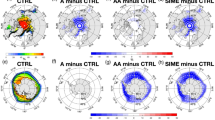Abstract
A model of lake ice was coupled with a model of lake temperature and evaporation to assess the possible effect of ice cover on the late-Pleistocene evaporation rate of Lake Lahontan. The simulations were done using a data set based on proxy temperature indicators and features of the simulated late-Pleistocene atmospheric circulation over western North America. When a data set based on a mean-annual air temperature of 3° C (7° C colder than present) and reduced solar radiation from jet-stream induced cloud cover was used as input to the model, ice cover lasting ∼ 4 months was simulated. Simulated evaporation rates (490–527 mm a−1) were ∼ 60% lower than the present-day evaporation rate (1300 mm a−1) of Pyramid Lake. With this reduced rate of evaporation, water inputs similar to the 1983 historical maxima that occurred in the Lahontan basin would have been sufficient to maintain the 13.5 ka BP high stand of Lake Lahontan.
Similar content being viewed by others
References
Benson LV (1981) Paleoclimatic significance of lake-level fluctuations in the Lahontan Basin. Quat Res 16:390–403
Benson LV, Thompson RS (1987) Lake-level variation in the Lahontan Basin for the past 50000 years. Quat Res 28:69–85
Brutsaert W (1982) Evaporation into the atmosphere. D Reidel, Dordrecht
De Bruin HAR, Wessels HRA (1988) A model of the formation and melting of ice on surface waters. J Appl Meteor 27:164–173
Dohrenwend JC (1984) Nivation landforms in the western Great Basin and their paleoclimatic significance. Quat Res 19:312–324
Ficke JF (1972) Comparison of evaporation computation methods, Pretty Lake, Lagrange County, northeastern Indiana. US Geol Surv Prof Paper 686-A
Hostetler S (1987) Simulation of lake evaporation with an energy balance-eddy diffusion model of lake temperature: model development and validation, and application to lake-level variations at Harney-Malheur Lake, Oregon. PhD Thesis, University of Oregon, Eugene, USA
Hostetler S, Bartlein PJ (1990) Simulation of lake evaporation with application to modeling lake-level variations at Harney-Malheur Lake, Oregon. Water Resoure Res 26(10):2603–2612
Hostetler S, Benson LV (1990) Paleoclimatic implications of the high stand of Lake Lahontan derived from models of evaporation and lake level. Clim Dyn 4:207–217
Kutzbach JE, Guetter PJ (1986) The influences of changing orbital parameters and surface boundary conditions on climate simulations for the past 18 000 years. J Atmos Sci 43:1726–1759
Maykut GN, Untersteiner N (1971) Some results from a time dependent, thermodynamic model of sea ice. J Geophys Res 76:1550–1575
Mifflin MD, Wheat MM (1979) Pluvial lakes and estimated pluvial climates of Nevada. Nev Bur Mines Geol Bull 94
Mullen PC, Warren SG (1988) Theory of the optical properties of lake ice. J Geophys Res 93(D7):8403–8414
Patterson JC, Hamblin PF (1988) Thermal simulation of a lake with winter ice cover. Limnol Oceanogr 33(3):323–338
Pielke RA (1984) Mesoscale meteorological modeling. Academic Press, Orlando, USA
Russell IC (1885) Geological history of Lake Lahontan, a Quaternary lake of northwest Nevada. US Geol Surv Monograph 11
Shearman DJ, Smith AJ (1985) Ikaite, the parent mineral of jarrowite-type pseudomorphs. Proc Geol Assoc 96:305–314
Smith GI, Benson LV, Currey DR (1989) Quaternary geology of the Great Basin. IGC Field Trip Guidebook T117. American Geophysical Union, Washington, DC, USA
Thompson RS (1984) Late Pleistocene and Holocene environments in the Great Basin. PhD Thesis, University of Arizona, Tucson, Arizona, USA
Thompson RS, Mead JI (1982) Late Quaternary environments and biogeography in the Great Basin. Quat Res 25:39–55
Warren SG (1982) Optical properties of snow. Rev Geophys Space Phys 20:67–69
Author information
Authors and Affiliations
Rights and permissions
About this article
Cite this article
Hostetler, S.W. Simulation of lake ice and its effect on the late-Pleistocene evaporation rate of Lake Lahontan. Climate Dynamics 6, 43–48 (1991). https://doi.org/10.1007/BF00210581
Received:
Accepted:
Issue Date:
DOI: https://doi.org/10.1007/BF00210581




